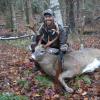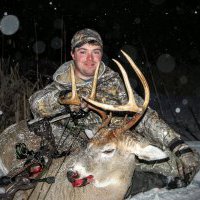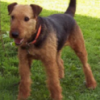Penn State Deer Study
-
Similar Content
-
By CrossOvertheRiverOutdoors
Hey Turkey hunters! Check out my latest video on YouTube! This is a Pennsylvania turkey hunt from last spring! The opening morning of the PA season. This long beard strutted right in to the decoy and was only 10 yards away when I shot him! Please subscribe to my YouTube channel Cross Over the River Outdoors to stay updated with my hunting adventures and new videos! Post and share as well! Enjoy the hunt guys and gals!
-
By JeepInPA
FOR SALE: Pennsylvania Camp, Shed and 5 Acres Near Hunting, Fishing and ATV Trails
600 square foot cabin built in 2011. Cabin has electricity and will include most furniture and appliances.
Access to ATV trails. 10 minutes from the Snow Shoe Rails to Trails. Local hunting and fishing in the Moshannon State Forest.
Includes 10x18 shed and deer feeders.
Located in Grassflat, Cooper Township, Clearfield County.
Asking $99,000. Serious offers considered.
Call or text 814-574-4471
Email [email protected]
-
By mike rossi
Ohio (Not a Northeastern state, but borders New York)
Youth Nonresident license only $10, Youths given priority in Managed Dove Field Controlled hunt lotteries.
Nonresident License $125
3 Day Nonresident license $40
Youth Nonresident $10
Where to purchase license or to purchase online or by mail: http://www.ohiodnr.com/wildlife/dow/regulations/vendor.aspx
The Ohio Wildlife Council approved the state's 2013-2014 early migratory game bird hunting seasons at its scheduled meeting on Wednesday, July 17, according to the Ohio Department of Natural Resources (ODNR). Sept. 1 kicks off the state’s bird hunting seasons for mourning dove.
Ohio's dove season is Sept. 1-Oct. 21 and Dec. 15-Jan. 2, 2014, with a daily limit of 15 birds and a possession limit of 45 birds after the second day.
Controlled dove hunts will be offered at Fallsville, Rush Run, Spring Valley, Indian Creek and Bott state wildlife areas. Bott Wildlife Area will hold its drawings at the Indian Creek Headquarters. These controlled hunts will take place on Sunday, Sept. 1, and Monday, Sept. 2; hunting hours will be noon to sunset. Controlled dove hunts will also be offered at St. Marys Fish Hatchery on Sept. 1-2, 7, 14 and 21. Youths 17-years-old and younger will be given priority on Sept. 1-2.
Opening day drawings for all of these hunts will take place at noon on Saturday, Aug. 24, at the respective public area headquarters. Drawings for the other hunts will be held the day of the hunt at noon. Maps and details are available at wildohio.com. Questions about these hunts should be directed to the ODNR Division of Wildlife’s District Five office at 937-372-9261.
Hunters must obtain a new HIP certification each year. Licenses, permits and stamps are available online at the Wild Ohio Customer Center.
Hunting hours are sunrise to sunset. The only exceptions will be on wildlife areas that have specially posted hunting times for doves. The 2013-14 Ohio Hunting and Trapping Regulations and the 2013 Migratory Game Bird Hunting Seasons brochure can be found online at wildohio.com. The 2013 Migratory Game Bird Hunting Seasons brochure will be available by late August at license outlets, ODNR Division of Wildlife district offices or by calling 800-WILDLIFE. Visit the ODNR website at ohiodnr.gov . For some tasty dove recipes, check out our Wild Ohio Cookbook.
Ohio Managed Dove Fields
Download the locations of all dove fields and parking areas using Google Earth. For hyper links click here: http://dnr.state.oh.us/Home/HuntingandTrappingSubhomePage/DoveFieldLocations/tabid/18642/Default.aspx
Central Ohio
Big Island Wildlife Area
Deer Creek Wildlife Area
Delaware Wildlife Area
Mackey Ford Wildlife Area
Northwest Ohio
Killdeer Plains Wildlife Area
Lake La Su An Wildlife Area
Pickerel Creek Wildlife Area
Resthaven Wildlife Area
Wyandot Wildlife Area
Northeast Ohio
Berlin Lake Wildlife Area
Funk Bottoms Wildlife Area
Grand River Wildlife Area
Highlandtown Wildlife Area
Killbuck Marsh Wildlife Area
Mosquito Creek Wildlife Area
West Branch State Park Wildlife Area
Southeast Ohio
AEP Recreation Land
Crown City Wildlife Area
Dillon Wildlife Area-Area 2
Dillon Wildlife Area-Area 3
Egypt Wildlife Area
Salt Fork Wildlife Area
Tri-Valley Wildlife Area
Woodbury Wildlife Area-Central Section
Woodbury Wildlife Area-Northwest Section
Southwest Ohio
Caesar Creek Wildlife Area
Clark Lake
Darke Wildlife Area
Della Gates & Edward Charles Bott Wildlife Area
East Fork Wildlife Area
Fallsville Wildlife Area
Fallsvile Wildlife Area-South Unit
Indian Creek Wildlife Area
Paint Creek Lake Wildlife Area
Pater Wildlife Area
Rush Run Wildlife Area
Spring Valley Wildlife Area
-
By mike rossi
Rhode Island, PA, and Ontario Dove Seasons, Sunday hunting in Ontario
Rhode Island
MIGRATORY GAME BIRDS
Mourning Doves -The open season for mourning doves is statewide:
September 14 to October 13;
October 19 to November 9;
December 18 to January 4
Shooting hours are:
First split: noon to sunset.
Second and third split: sunrise to sunset
Daily bag / possession limits: 12 / 24
JOHN L. CURRAN STATE PARK/MANAGEMENT AREA:
9.12.3 The hunting of and/or possession of Mourning Dove or Wild Pigeons (Rock Dove) is prohibited. Note from us: Wild or Feral Pigeons are the same thing as Rock Doves or Rock Pigeons. In other parts of RI these birds are an unprotected species with no closed season. This special regulation is no doubt a socio-political one.
Fluorescent Orange Requirements: Exemptions: first segment dove hunters, not required in areas limited to Archery by regulation.
Hunting Licenses are available from DEM Division of Licensing at 235 Promenade
St., Providence, RI 02908 (401) 222-3576; most city and town clerks (licenses only);
most sporting goods stores; and http://www.dem.ri.gov/. To replace a lost or stolen license
or permit, contact DEM Division of Licensing.
Non-Resident Hunting (must be 15 years old)1 ............................... $45.00
Non-Resident (3-day hunting) Tourist License ................... $16.00
Resident and Non-Resident active military personnel ......... $18.00
RI HIP Permit ...................................................................... No fee (SEE BELOW)
Migratory Bird Harvest Information Program (HIP)
The HIP program was designed to aid state and wildlife agencies
and the US Fish & Wildlife Service (USFWS) better information
on managing our nation’s migratory bird resources.
All migratory bird hunters need to obtain a permit and answer
a small survey. HIP permits are available through all license
vendors and DEM.
PA Dove Hunting
Doves
Sept. 1 – Oct. 1 bag limit 15
Oct. 29 - Nov. 26 bag limit 15
Dec. 26 - Jan. 4 bag limit 15
During the Sept. 1-Oct. 1 portion of the dove season, hunting hours are noon to sunset. During the other seasons, hunting hours are one-half hour before sunrise to sunset.
Possession limit is twice the daily bag limit.
A valid PA Migratory Game Bird License is required to hunt doves and also is how you register for HIP in PA.
Nonresident Adult Hunting 17 & up $101.70
Nonresident Junior Hunting 12 - 16 $ 41.70
Nonresident 7-Day Small Game 12 & up $ 31.70
Nonresident Migratory Game Bird 12 & up $ 6.70
Reduced-Fee Resident Military Personnel Hunting $2.70
Reduced-Fee Resident PA National Guard or Reserves Hunting $2.70
Reduced-Fee Resident Prisoner of War Hunting $2.70
To purchase PA hunting Licenses Online: https://www.pa.wildlifelicense.com/start.php
Out of State License Agents: http://www.portal.state.pa.us/portal/server.pt?open=514&objID=596048&mode=2
In State License Agents: http://www.portal.state.pa.us/portal/server.pt?open=514&objID=596049&mode=2
Ontario Canada Introductory Dove season & Sunday Hunting
Canadian Providence of Ontario allows dove hunting the fall of 2013!
Central District: September 3 to November 11
South District: September 5 to November 13
Bag limit and possession limits in both districts is: 15/45
Link for info on new “introductory dove season”: http://www.ec.gc.ca/rcom-mbhr/default.asp?lang=en&n=99FDEC59-1#_docOpen
Link for nonresident hunting licenses: http://www.mnr.gov.on.ca/en/Business/FW/2ColumnSubPage/261219.html
PENDING – Sunday Hunting
Periodic changes may be made to gun hunting on Sundays
in areas south of the French and Mattawa rivers. To confirm
the status in the municipality in which you wish to hunt,
please check the Sunday hunting information available at
ontario.ca/hunting.
Sunday Hunting - April 1, 2013 to August 31, 2013
• Effective April 1, 2013 to August 31, 2013: List of Municipalities in Southern Ontario Where Sunday Gun Hunting is Permitted (PDF, 59 kb)
• Effective April 1, 2013 to August 31, 2013: Colour Map Showing Where Sunday Gun Hunting is Permitted in Southern Ontario (PDF, 1.6 mb)
• Effective April 1, 2013 to August 31, 2013: B&W Map Showing Where Sunday Gun Hunting is Permitted in Southern Ontario (PDF, 1.2 mb)
-
By burmjohn
I can't speak for everyone, however last year I could have shoveled the acorns off the ground almost everywhere on our property. Last year was quite a year for acorns in New York and I believe it had accounted for less action and movement during the hunting season, specifically bow season. Deer love acorns, and if they are dropping that is what they are going to hit first regardless of food plots and other food sources you have in the area.
If there are acorns everywhere, specifically in the area's where deer feel secure, near bedding area's and thickets why would a deer move out of those area's when they have everything they need right there? Most of the success around my area were people that had hunted near deer bedding area's. While others who did not observed minimal movement during the bow season, which was the complete opposite of previous years where their stands / blinds had a lot of action and success. Last year I observed that the deer movement basically changed overnight once those acorns started dropping. We had two trail camera’s up one on a major travel route to our two small food plots and another in the field. The deer were still hitting the fields at night, however action during the day nearly stopped on the fields once those acorns starting dropping and the one travel route became a ghost town, the trail camera was snapping a fraction of what it was before.
This year is different, I noticed a lot less acorns in the oak tree’s, and hope that this may cause some more movement during the day. Those with food plots might see the plots getting hit more frequently and earlier then last year. If you have an area's where acorns drop constantly year after year that might be the place to setup shop this year. There are a few nice white oaks where we had setup a friend to hunt during the bow season, unfortunately there was not a lot of action in this spot because the deer had way to many other places to fill up on. Something else to thing about is how has last years acorn crop effected this years deer population. I was speaking with a friend yesterday, and he is could not believe the amount of bear cubs and fawns he has seen this year, and attributes that the to the acorn crop of last year.
Acorn information:
“One ounce of dried acorn has on average 140 calories, of which 9 grams is fat, 15 grams is carbohydrate, and 2 grams is protein. Using some simple math, that means a whopping 50% (72 calories) of the caloric intake is from fat! Now you now why deer pig out on them prior to the onset of winter. But the buck doesn’t stop there.
Carbohydrates make up 43% of the caloric intake, which can also be converted and stored by a deer’s body as fat or immediately used as energy. Protein makes up just 6% of the caloric intake, but protein is not very important for adult deer at this time of year. However, growing fawns appreciate the additional protein because they need it to increase muscle mass prior to the dead of winter.” - Source: http://www.buckmanag...iled-deer-food/
The QDMA has an article “Scouting After The Harvest” which covers some great points about what to look for when inspecting an Oak tree.
“If you are inspecting an oak, do you see many acorn caps, a good indication that something has eaten the acorns? In fact, if deer are heavily using a particular oak tree, you shouldn’t find many acorns because they are eating them as fast as they fall. Obviously, signs that deer are eating the food source are important. However, the one key sign I look for and will instantly give me confidence that deer are using the area is fresh deer droppings. If old droppings are present too, I’m hanging a stand! That means that deer have been using the area consistently for a while.”
What have you noticed in your hunting area’s? Do you notice any deer movement changes during banner acorn years? How is the acorn crop this year looking as opposed to previous years?
This post has been promoted to an article, click here to view.
-
-
Recently Browsing 0 members
No registered users viewing this page.








Recommended Posts
Join the conversation
You can post now and register later. If you have an account, sign in now to post with your account.